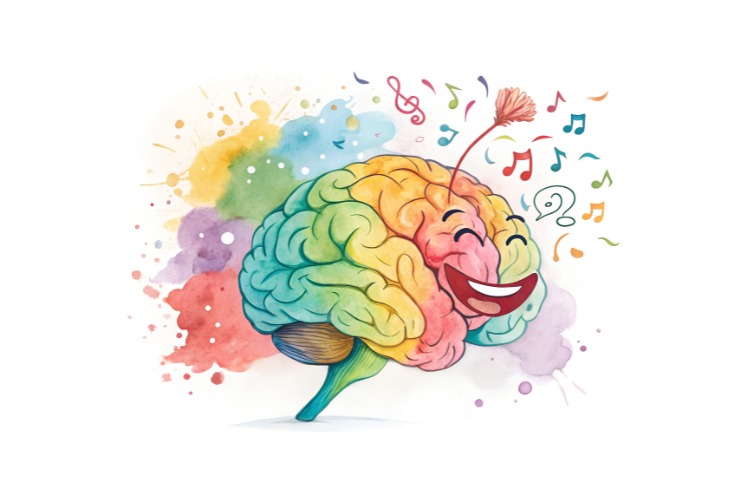Introduction
Happiness, one of humanity’s most sought-after states, has long been considered a philosophical and psychological phenomenon. However, advances in neuroscience over the past several decades have revealed that happiness is fundamentally a biological process orchestrated by complex neural networks within the brain. Understanding the neurobiology of happiness not only provides insights into human behavior and well-being but also opens new avenues for treating mood disorders and enhancing quality of life.
The scientific study of happiness, or positive affect, has evolved from subjective philosophical inquiry to objective neurobiological investigation. Modern neuroscience demonstrates that happiness emerges from intricate interactions between neurotransmitters, neural circuits, and brain regions that have evolved to promote survival and social bonding. This article explores the neurobiological mechanisms underlying happiness, examining how the brain generates, processes, and maintains positive emotional states.
The Neural Architecture of Happiness
Key Brain Regions
The experience of happiness involves multiple interconnected brain regions working in concert. The limbic system, often called the “emotional brain,” plays a central role in processing positive emotions. The nucleus accumbens, part of the brain’s reward system, is particularly crucial for experiencing pleasure and motivation. This small structure, located in the ventral striatum, responds to rewarding stimuli and reinforces behaviors that promote survival and reproduction.
The prefrontal cortex, responsible for executive functions and decision-making, significantly influences happiness through its regulation of emotional responses. The ventromedial prefrontal cortex specifically processes reward valuation and helps maintain positive mood states. Meanwhile, the anterior cingulate cortex contributes to emotional processing and helps integrate cognitive and emotional information.
The amygdala, traditionally associated with fear and anxiety, also plays a role in positive emotions. Research shows that different subnuclei within the amygdala can either promote or inhibit positive emotional states, depending on the context and individual differences in neural connectivity.
The Reward System
The mesolimbic dopamine system, consisting of dopamine neurons in the ventral tegmental area (VTA) that project to the nucleus accumbens, forms the backbone of the brain’s reward system. This circuit evolved to motivate behaviors essential for survival, such as seeking food, shelter, and mates. When activated, it creates feelings of pleasure and drives goal-directed behavior.
Importantly, the reward system responds not only to the actual receipt of rewards but also to the anticipation of rewards. This anticipatory component of happiness helps explain why planning enjoyable activities or working toward goals can be as rewarding as achieving them. The dopamine system encodes prediction errors, signaling when outcomes are better or worse than expected, thereby facilitating learning and adaptation.
Neurochemical Foundations of Happiness
Dopamine: The Motivation Molecule
Dopamine is perhaps the most well-known neurotransmitter associated with happiness and reward. Produced primarily in the VTA and substantia nigra, dopamine facilitates communication between neurons involved in reward processing, motivation, and motor control. Contrary to popular belief, dopamine is not simply a “pleasure chemical” but rather signals the salience and motivational value of stimuli.
The dopamine system operates through two primary pathways: the mesolimbic pathway, which mediates reward and motivation, and the mesocortical pathway, which influences executive function and emotional regulation. Dysfunction in these pathways is implicated in various mood disorders, including depression and anhedonia (the inability to experience pleasure).
Serotonin: The Mood Stabilizer
Serotonin, synthesized primarily in the raphe nuclei of the brainstem, profoundly influences mood, sleep, appetite, and social behavior. Approximately 90% of the body’s serotonin is produced in the gut, highlighting the connection between physical and mental well-being. In the brain, serotonin modulates the activity of other neurotransmitter systems and helps maintain emotional balance.
Low serotonin levels are associated with depression, anxiety, and impulsivity, while optimal levels promote feelings of well-being, contentment, and social connectedness. The serotonin system’s extensive projections throughout the brain allow it to influence virtually all aspects of behavior and cognition related to happiness.
Oxytocin: The Social Bonding Hormone
Oxytocin, produced in the hypothalamus and released by the posterior pituitary gland, plays a crucial role in social bonding, empathy, and trust. Often called the “love hormone,” oxytocin levels increase during positive social interactions, childbirth, and romantic encounters. This neuropeptide enhances the salience of social cues and promotes prosocial behavior, contributing to the happiness derived from relationships and community connections.
Research demonstrates that oxytocin administration can increase generosity, trust, and emotional recognition, while oxytocin receptor variants are associated with individual differences in social behavior and relationship satisfaction. The oxytocin system illustrates how happiness is fundamentally connected to our social nature as humans.
Endorphins: Natural Pain Relief and Pleasure
Endorphins, the body’s natural opiates, are released during exercise, laughter, and other pleasurable activities. These neurotransmitters bind to opioid receptors in the brain, producing analgesic effects and feelings of euphoria. The endorphin system helps explain phenomena such as “runner’s high” and the mood-enhancing effects of physical activity.
The release of endorphins is triggered by both physical and psychological stressors, serving as a natural mechanism for coping with challenges. This system demonstrates how the brain has evolved mechanisms to promote resilience and recovery from adversity.
Neural Plasticity and Happiness
The Plastic Brain
One of the most exciting discoveries in neuroscience is the brain’s remarkable capacity for neuroplasticity—the ability to reorganize and form new neural connections throughout life. This plasticity extends to the neural circuits involved in happiness, suggesting that well-being is not fixed but can be enhanced through specific practices and interventions.
Studies of meditation practitioners show increased gray matter density in brain regions associated with learning, memory, and emotional regulation. Similarly, cognitive-behavioral therapy produces measurable changes in neural activity patterns, demonstrating that psychological interventions can literally rewire the brain for greater happiness.
Neurogenesis and Mood
The discovery of adult neurogenesis—the formation of new neurons in the adult brain—has revolutionized our understanding of brain plasticity and mood regulation. The hippocampus, crucial for memory formation and stress regulation, continues to generate new neurons throughout life. This process is enhanced by exercise, learning, and positive experiences while being suppressed by chronic stress and depression.
Antidepressant medications appear to work, in part, by promoting neurogenesis in the hippocampus, suggesting that the growth of new neurons may be essential for mood improvement and the maintenance of happiness.
The Role of Genetics and Environment
Genetic Influences
Research using twin studies suggests that approximately 50% of happiness levels are determined by genetic factors. Specific genetic variants affect neurotransmitter production, receptor sensitivity, and neural development, creating individual differences in baseline happiness and susceptibility to mood disorders.
The serotonin transporter gene (5-HTTLPR) polymorphism, for example, influences how individuals respond to stress and negative life events. People with certain variants may be more vulnerable to depression but also more responsive to positive interventions, illustrating the complex interaction between genes and environment.
Environmental Factors
Despite genetic influences, environmental factors play a crucial role in determining happiness levels. Social relationships, meaningful work, physical health, and life circumstances all contribute to subjective well-being. The brain’s plasticity ensures that positive environmental changes can lead to lasting improvements in happiness, even in individuals with genetic predispositions to mood disorders.
Research on epigenetics reveals that environmental factors can influence gene expression without changing DNA sequences, providing a mechanism through which experiences can have lasting effects on brain function and happiness.
Implications for Mental Health and Well-Being
Therapeutic Applications
Understanding the neurobiology of happiness (more here: https://www.totalmedic.pl/neurobiologia-szczescia-jak-mozg-steruje-twoim-zyciem/) has led to more effective treatments for depression, anxiety, and other mood disorders. Pharmacological interventions targeting specific neurotransmitter systems, combined with psychotherapy approaches that promote neuroplasticity, offer hope for individuals struggling with mental health challenges.
Novel treatments such as ketamine therapy, which affects the glutamate system, and psychedelic-assisted therapy, which influences serotonin receptors, demonstrate the potential for innovative approaches based on neurobiological insights.
Prevention and Enhancement
Neurobiological research also informs strategies for preventing mental health problems and enhancing well-being in healthy individuals. Regular exercise, mindfulness meditation, social connection, and adequate sleep all promote the neural mechanisms underlying happiness.
The field of positive psychology, informed by neuroscience, focuses on building strengths and promoting flourishing rather than merely treating illness. This approach recognizes that happiness is not simply the absence of negative emotions but the presence of positive neural states that can be cultivated and maintained.
Future Directions and Conclusions
As neuroscience techniques continue to advance, our understanding of happiness will become increasingly sophisticated. Emerging technologies such as optogenetics, which allows precise control of neural activity, and advanced brain imaging methods promise to reveal new insights into the neural basis of well-being.
The integration of neuroscience with other fields, including psychology, genetics, and social sciences, will provide a more complete picture of human happiness. This multidisciplinary approach is essential for developing effective interventions and understanding the complex interplay between biological, psychological, and social factors in determining well-being.
The neurobiology of happiness reveals that our emotional experiences are grounded in specific brain mechanisms that evolved to promote survival and social cooperation. By understanding these mechanisms, we can develop more effective approaches to treating mental illness, enhancing well-being, and creating environments that support human flourishing. The brain’s remarkable capacity for change offers hope that happiness, while influenced by genetics and circumstances, can be cultivated and sustained through informed intervention and practice.
This neurobiological perspective on happiness does not diminish its subjective importance or meaning but rather provides a foundation for understanding and optimizing one of humanity’s most fundamental experiences. As we continue to unravel the mysteries of the brain, we move closer to a world where the pursuit of happiness is informed by scientific understanding and supported by evidence-based interventions.



































